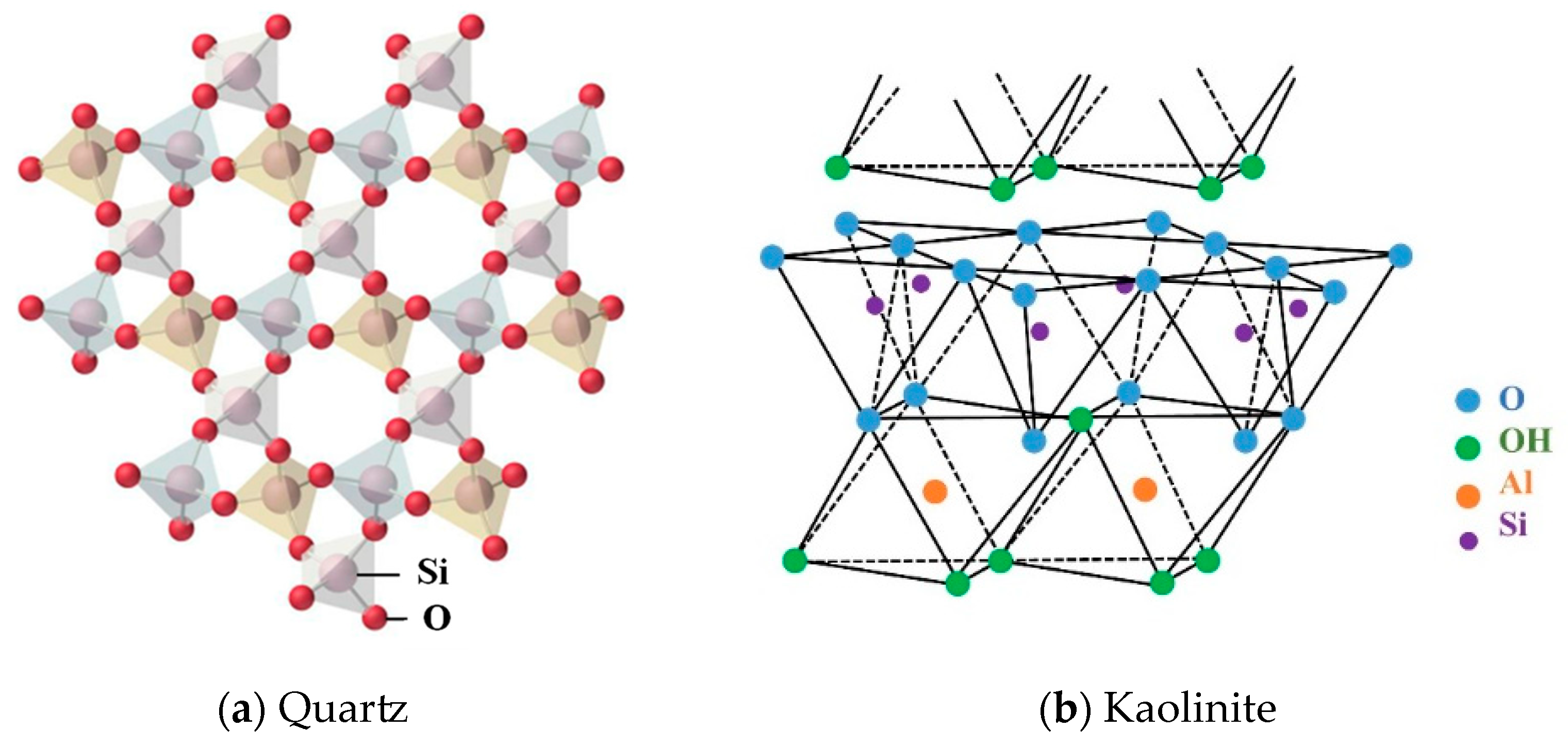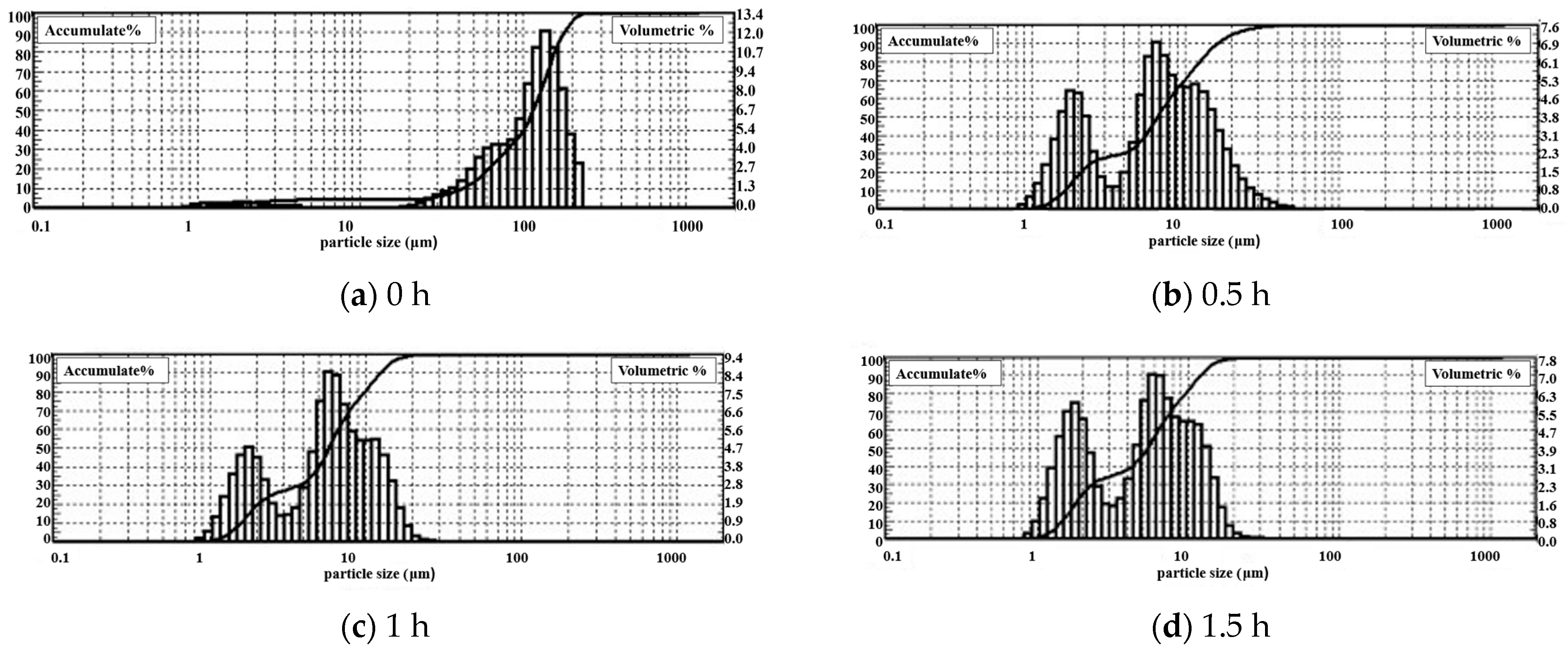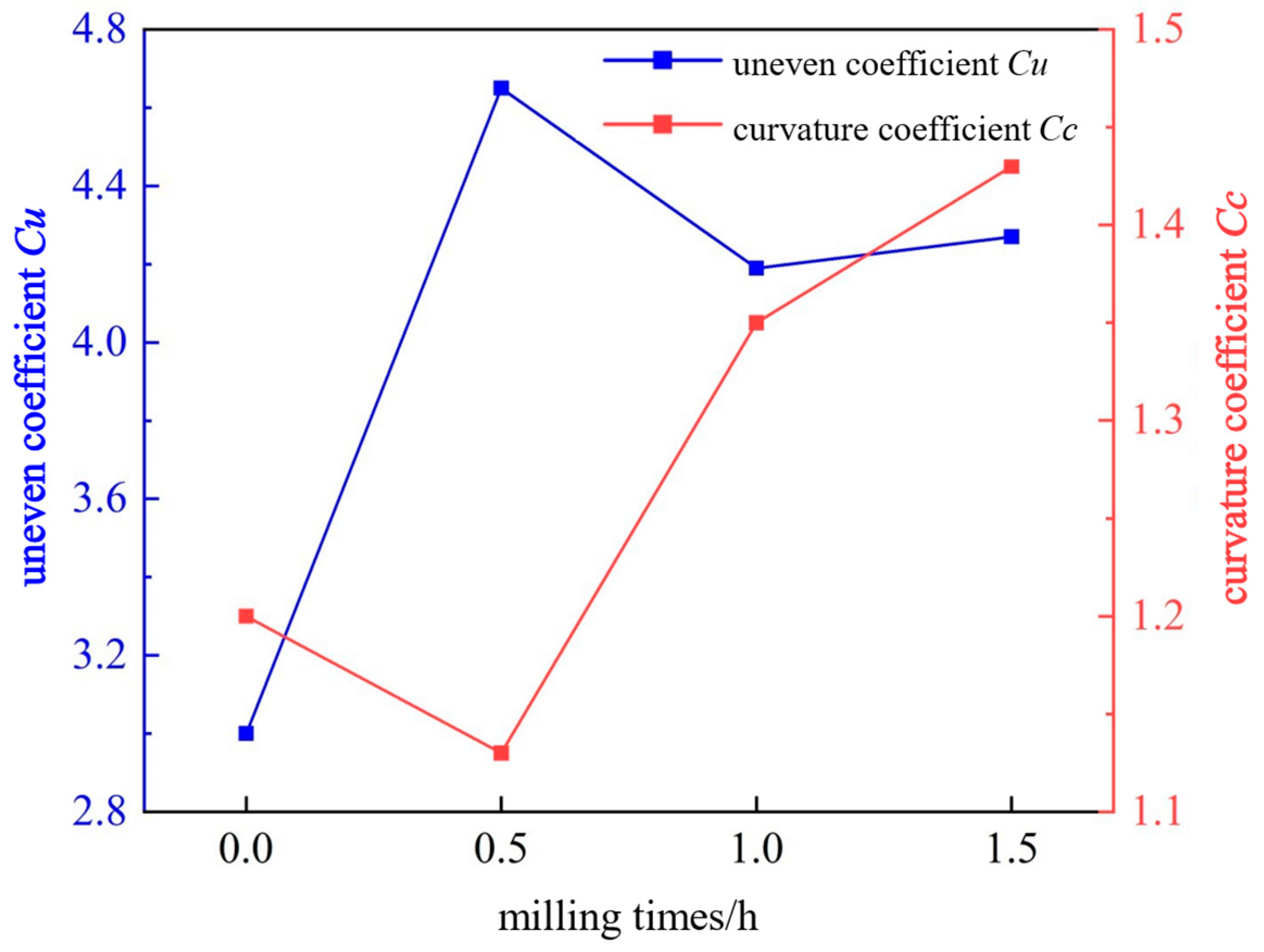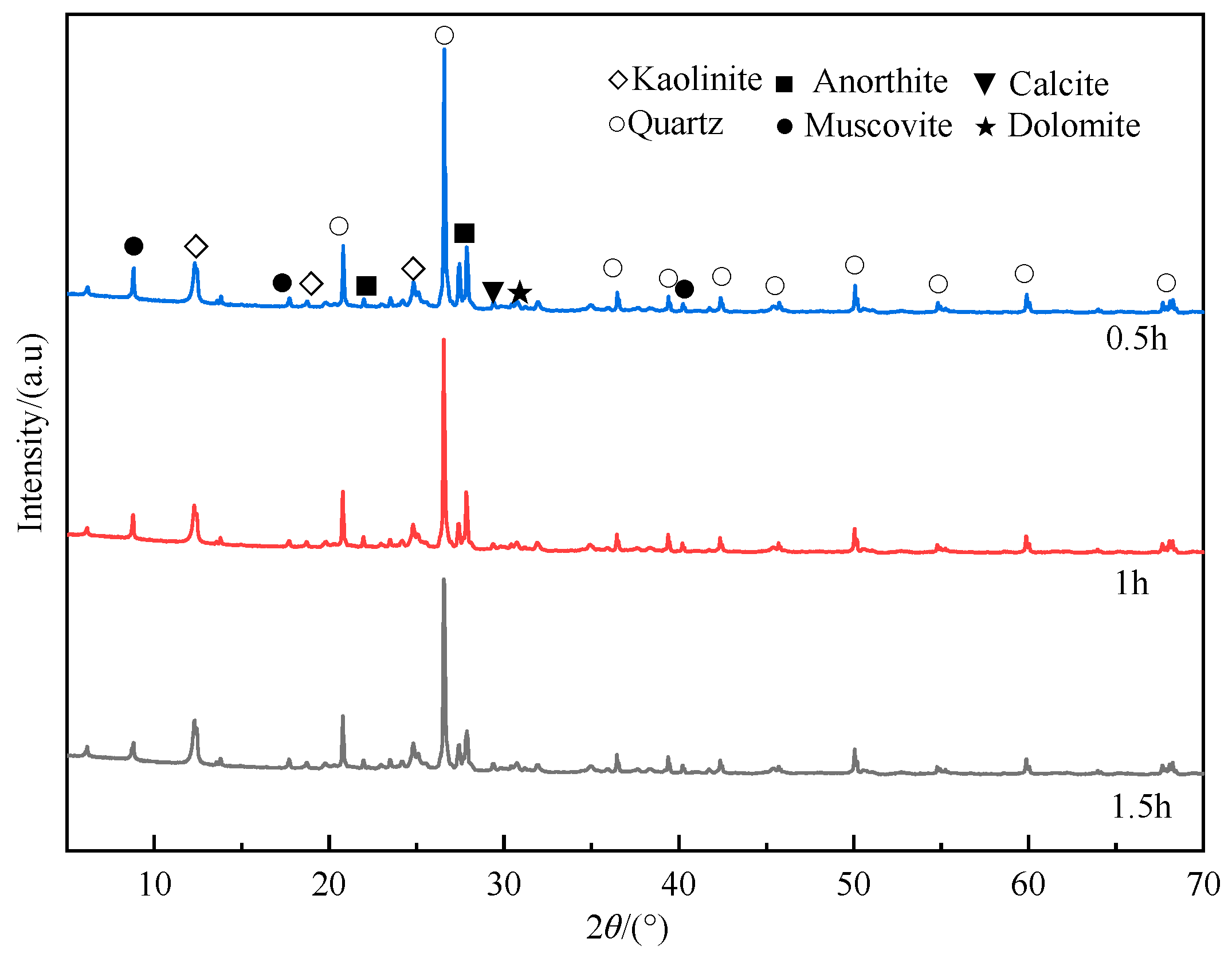Research on the Mechanical Activation Mechanism of Coal Gangue and Its CO2 Mineralization Effect
Abstract
1. Introduction
2. Materials and Methods
2.1. Raw Materials
2.2. Experimental Methods and Plans
2.2.1. Mechanical Activation and Schemes
2.2.2. CO2 Mineralization Process and Plan for Mechanically Activated Gangue
2.3. Microscopic Analysis
3. Results and Discussion
3.1. Mechanical Activation Mechanism and Effect
3.1.1. Particle Size of Mechanically Activated Gangue
3.1.2. Mineral Composition of Mechanically Activated Gangue
3.1.3. Chemical Groups of Mechanically Activated Gangue
3.1.4. Microstructure of Mechanically Activated Gangue
3.2. CO2 Mineralization Effect of Mechanically Activated Gangue
3.2.1. Mineral Composition of Gangue After CO2 Mineralization
3.2.2. Microstructure of Gangue After CO2 Mineralization
3.2.3. CO2 Mineralization Effect on Coal Gangue
4. Perspective for Future Research
5. Conclusions
Author Contributions
Funding
Institutional Review Board Statement
Informed Consent Statement
Data Availability Statement
Conflicts of Interest
Abbreviations
| CBSW | coal-based solid wastes |
| DPLPST | dry powder laser particle size testing |
| XRD | X-ray diffractometer |
| FTIR | Fourier-transform infrared spectrometer |
| SEM | scanning electron microscope |
| TG | thermogravimetric |
| NCFM | negative carbon-filling material |
| CPB | cemented-paste backfill |
| XRF | X-ray fluorescence spectrometer |
References
- Yang, F. Current situation analysis and prospect discussion on comprehensive utilization of coal resources for power generation. China Coal 2020, 46, 67–74. [Google Scholar] [CrossRef]
- Guo, Y.; Zhang, Y.; Cheng, F. Industrial development and prospect about comprehensive utilization of coal gangue. CIESC J. 2014, 65, 2443–2453. [Google Scholar]
- Huang, X. Research on Identification and Impact of Key Elements in Energy Security Based on the Dual Perspectives of Low-Carbon Consumption Behavior and Supply-Demand. Ph.D. Thesis, Nanchang University, Nanchang, China, 2024. [Google Scholar]
- Mi, J.; Ma, X. Development Trend Analysis of Carbon Capture, Utilization and Storage Technology in China. Proc. CSEE 2019, 39, 2537–2544. [Google Scholar] [CrossRef]
- Ochedi, F.O.; Liu, Y.; Adewuyi, Y.G. State-of-the-art review on capture of CO2 using adsorbents prepared from waste materials. Process Saf. Environ. Prot. 2020, 139, 1–25. [Google Scholar] [CrossRef]
- Wang, S.; Shen, Y.; Sun, Q.; Liu, L.; Shi, Q.; Zhu, M.; Zhang, B.; Cui, S. Underground CO2 storage and technical problems in coal miningarea under the “dual carbon” target. J. China Coal Soc. 2022, 47, 45–60. [Google Scholar] [CrossRef]
- Chao, Q.; Chen, W. The Summary of Carbon Capture and Storage Technology and Its Impact on China. Adv. Earth Sci. 2006, 291–298. [Google Scholar] [CrossRef]
- Ji, L. Carbon Dioxide Sequestration by Mineralisation Ofcoal Fly Ash. Ph.D. Thesis, China University of Mining and Technology, Beijing, China, 2018. [Google Scholar]
- Yang, T.; Hu, J.; Han, S.; Min, H.; Li, Y. Research progress on CO2 mineralization filling technology in coal mines. J. North China Inst. Sci. Technol. 2023, 20, 30–35. [Google Scholar] [CrossRef]
- Liu, L.; Wang, S.; Zhu, M.; Zhang, B.; Hou, D.; Zhen, C.; Zhao, Y.; Zhang, X.; Wang, X.; Mei, W. CO2 storage-cavern construction and storage method based on functional backfill. J. China Coal Soc. 2022, 47, 1072–1086. [Google Scholar] [CrossRef]
- Jin, L. Experimental Study on Performance Optimization of Mechanically Activated Coal Gangue-Based Grouting Materials. Master’s Thesis, China University of Mining and Technology, Xuzhou, China, 2022. [Google Scholar]
- Feng, T. Preparation of Thermally Activated Copper Tailings-Gangue and Alkali-Excited Cementitious Materials. Master’s Thesis, Kunming University of Science and Technology, Kunming, China, 2021. [Google Scholar]
- Unuabonah, E.I.; Adebowale, K.O.; Olu-Owolabi, B.I.; Yang, L.Z.; Kong, L.X. Adsorption of Pb(II) and Cd(II) from aqueous solutions onto sodium tetraborate-modified Kaolinite clay: Equilibrium and thermodynamic studies. Hydrometallurgy 2008, 93, 1–9. [Google Scholar] [CrossRef]
- Yang, F.Q.; Wu, C. Mechanism of mechanical activation for spontaneous combustion of sulfide minerals. Trans. Nonferrous Met. Soc. China 2013, 23, 276–282. [Google Scholar] [CrossRef]
- Li, X.H.; Zhang, Y.J.; Pan, L.P.; Wei, Y.S. Effect of mechanical activation on dissolution kinetics of neutral leach residue of zinc calcine in sulphuric acid. Trans. Nonferrous Met. Soc. China 2013, 23, 1512–1519. [Google Scholar] [CrossRef]
- Zhao, S.X.; Wang, G.R.; Yang, H.Y.; Chen, G.B.; Qiu, X.M. Agglomeration-aggregation and leaching properties of mechanically activated chalcopyrite. Trans. Nonferrous Met. Soc. China 2021, 31, 1465–1474. [Google Scholar] [CrossRef]
- Zhang, Y.; Che, M.; Liu, Y.; Che, Z.; Fu, Y. Experimental study on the extraction of aluminum and iron from coal gangue by thermal activation and acid leaching method. Energy Environ. Prot. 2024, 38, 179–187. [Google Scholar]
- Liu, B.; Gu, X.; Li, Z.; Yang, B.; Wang, H.; Liu, J.; Nehdi, M.L.; Zhang, Y. Exploring microwave activation as a novel method for activating coal gangue: Focus on microwave activation mechanisms and hydration characteristics of cementitious supplementary materials. Constr. Build. Mater. 2024, 450, 138482. [Google Scholar] [CrossRef]
- Zhang, W.; Dong, C.; Huang, P.; Sun, Q.; Li, M.; Chai, J. Experimental Study on the Characteristics of Activated Coal Gangue and Coal Gangue-Based Geopolymer. Energies 2020, 13, 2504. [Google Scholar] [CrossRef]
- Zhang, J.; Li, B.; Xie, Y.; Li, C.; Zhou, N.; Guo, Y.; Li, Z.; Xie, H. Carbon negative backfill mining in coal mines for carbon neutralization: Chemical carbon fixation performances with mineralized gangue. Int. J. Rock Mech. Min. Sci. 2025, 186, 106016. [Google Scholar] [CrossRef]
- Huo, B.; Zhang, J.; Li, M.; Zhou, N.; Qiu, X.; Fang, K.; Wang, X. Effect of CO2 Mineralization on the Composition of Alkali-Activated Backfill Material with Different Coal-Based Solid Wastes. Sustainability 2023, 15, 4933. [Google Scholar] [CrossRef]
- Huo, B.; Zhang, Q.; Li, M.; Xing, S. Using recycled gangue to capture CO2 and prepare alkali-activated backfill paste: Adsorption and microevolution mechanisms. Fuel 2024, 358, 130194. [Google Scholar] [CrossRef]
- Ma, L.; Zhai, J.; Ichhuy, N. Experimental study on the preparation of water retention mining negative carbon filling material from CO2 mineralised coal-based solid waste. J. China Coal Soc. 2022, 47, 4228–4236. [Google Scholar] [CrossRef]
- Guo, Y.; Zhang, J.; Long, K.; Ma, J.; Gao, Y.; Li, B. Experimental study on CO2 sequestration capacity and mechanical characteristics evolution of solid wastes based carbon-negative backfill materials. Constr. Build. Mater. 2024, 440, 137457. [Google Scholar] [CrossRef]
- Chen, Q.; Zhu, L.; Wang, Y.; Chen, J.; Qi, C. The carbon uptake and mechanical property of cemented paste backfill carbonation curing for low concentration of CO2. Sci. Total Environ. 2022, 852, 158516. [Google Scholar] [CrossRef] [PubMed]
- Johannesson, B.; Utgenannt, P. Microstructural changes caused by carbonation of cement mortar. Cem. Concr. Res. 2001, 31, 925–931. [Google Scholar] [CrossRef]
- Wang, Z.; Zhang, J.; Xu, J.; Yan, H.; Zhao, Y.; Zheng, C. A Theoretical Study on Mineral Carbonation for CO2 Sequestration. J. Eng. Thermophys. 2008, 1063–1068. [Google Scholar] [CrossRef]
- Yan, H. Experimental Study of CO2 Sequestration from Flue Gasby Direct Aqueous Mineral Carbonation under Low-Medium Pressure Conditions. Ph.D. Thesis, Huazhong University of Science and Technology, Wuhan, China, 2015. [Google Scholar]
- Li, Y.; Su, R.; Zhou, Z.; Ji, R.; Zhao, J. Water-Rock Interaction of Granite from Borehole BS34 at Different Temperatures. J. Nucl. Radiochem. 2022, 44, 386–392. [Google Scholar]
- Ran, J.; Niu, B.; Zhang, L.; Pu, G.; Tang, Q. Thermogravimetric study on pyrolysis performance and mechanism of coal residue J. China Coal Soc. 2006, 640–644. [Google Scholar] [CrossRef]
- Jin, Z.; Song, C.; Wang, S.; Wang, R.; Li, R. Study of mixed pyrolysis of lignite and gangue. J. Eng. Thermophys. 2015, 36, 7–10. [Google Scholar]
- Zhang, Y. Research on the Combustion Characteristics and Influence Mechanism of Coal Gangue. Ph.D. Thesis, Shanxi University, Taiyuan, China, 2016. [Google Scholar] [CrossRef]












| Activation Method | Advantages | Disadvantages |
|---|---|---|
| Mechanical activation | 1. Simple operation 2. Mild reaction conditions 3. Environmentally friendly | 1. The equipment is susceptible to wear and tear 2. Only suitable for small-batch productions |
| Thermal activation | 1. Wide range of materials handled 2. High treatment capacity | 1. High energy consumption 2. Emission of greenhouse gases 3. High-temperature treatment may lead to the degradation of material performance |
| Chemical activation | Better mineralization | 1. Higher cost of chemical reagents 2. Negative environmental effect |
| Composite activation | Combining the advantages of several activation methods | 1. Difficult to control the activation effect 2. Equipment and operating costs are higher |
| Components | SiO2 | Al2O3 | CaO | Fe2O3 | K2O | Ti2O | MgO |
|---|---|---|---|---|---|---|---|
| Content/% | 61.56 | 21.51 | 3.71 | 4.97 | 2.96 | 1.90 | 1.49 |
| Milling Time (h) | Average Particle Size (μm) | D10 | D30 | D60 | D90 | Uneven Coefficient Cu | Curvature Coefficient Cc | Particle Size Grading |
|---|---|---|---|---|---|---|---|---|
| (μm) | (μm) | (μm) | (μm) | |||||
| 0 | 115.6 | 42.6 | 80.6 | 128.9 | 178.6 | 3 | 1.2 | Bad |
| 0.5 | 6.6 | 1.7 | 3.9 | 7.9 | 16.3 | 4.65 | 1.13 | Bad |
| 1 | 5.8 | 1.6 | 3.8 | 6.7 | 12.5 | 4.19 | 1.35 | Bad |
| 1.5 | 5.4 | 1.5 | 3.7 | 6.4 | 12.1 | 4.27 | 1.43 | Bad |
Disclaimer/Publisher’s Note: The statements, opinions and data contained in all publications are solely those of the individual author(s) and contributor(s) and not of MDPI and/or the editor(s). MDPI and/or the editor(s) disclaim responsibility for any injury to people or property resulting from any ideas, methods, instructions or products referred to in the content. |
© 2025 by the authors. Licensee MDPI, Basel, Switzerland. This article is an open access article distributed under the terms and conditions of the Creative Commons Attribution (CC BY) license (https://creativecommons.org/licenses/by/4.0/).
Share and Cite
Zhu, L.; Liu, C.; Duan, G.; Liu, Z.; Jin, L.; Zhou, Y.; Fang, K. Research on the Mechanical Activation Mechanism of Coal Gangue and Its CO2 Mineralization Effect. Sustainability 2025, 17, 2364. https://doi.org/10.3390/su17062364
Zhu L, Liu C, Duan G, Liu Z, Jin L, Zhou Y, Fang K. Research on the Mechanical Activation Mechanism of Coal Gangue and Its CO2 Mineralization Effect. Sustainability. 2025; 17(6):2364. https://doi.org/10.3390/su17062364
Chicago/Turabian StyleZhu, Lei, Chengyong Liu, Gang Duan, Zhicheng Liu, Ling Jin, Yuejin Zhou, and Kun Fang. 2025. "Research on the Mechanical Activation Mechanism of Coal Gangue and Its CO2 Mineralization Effect" Sustainability 17, no. 6: 2364. https://doi.org/10.3390/su17062364
APA StyleZhu, L., Liu, C., Duan, G., Liu, Z., Jin, L., Zhou, Y., & Fang, K. (2025). Research on the Mechanical Activation Mechanism of Coal Gangue and Its CO2 Mineralization Effect. Sustainability, 17(6), 2364. https://doi.org/10.3390/su17062364







